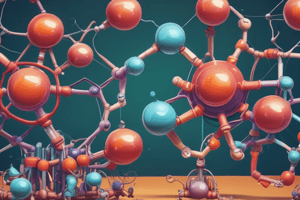Podcast
Questions and Answers
What happens to salt when it is dissolved in water?
What happens to salt when it is dissolved in water?
Which of the following describes a characteristic of a chemical change?
Which of the following describes a characteristic of a chemical change?
Why are chemical changes often harder to reverse than physical changes?
Why are chemical changes often harder to reverse than physical changes?
Which of the following is an example of a chemical change?
Which of the following is an example of a chemical change?
Signup and view all the answers
What products are formed when methane (CH4) is burned with oxygen (O2)?
What products are formed when methane (CH4) is burned with oxygen (O2)?
Signup and view all the answers
Which observation would indicate that a chemical change has occurred?
Which observation would indicate that a chemical change has occurred?
Signup and view all the answers
What defines a physical change?
What defines a physical change?
Signup and view all the answers
Which statement is true about the molecules during a chemical change?
Which statement is true about the molecules during a chemical change?
Signup and view all the answers
What process can be used to regain dissolved salt from saltwater?
What process can be used to regain dissolved salt from saltwater?
Signup and view all the answers
What type of change is represented by the burning of paper?
What type of change is represented by the burning of paper?
Signup and view all the answers
Study Notes
Overview of Chemistry Branches
- Pharmacology studies drug action and its interactions within the body.
- Organometallic Chemistry examines compounds containing bonds between carbon and a metal.
- Polymer Chemistry focuses on the chemistry of polymers.
- Physical Organic Chemistry investigates the relationship between molecular structure and reactivity.
- Stereochemistry studies the spatial arrangement of atoms in molecules and their impact on properties.
Inorganic Chemistry
- Inorganic Chemistry encompasses the study of inorganic compounds, excluding organic compounds.
- Examines crystal structures, minerals, metals, catalysts, and Periodic Table elements.
- Bioinorganic Chemistry studies metal ions' interactions with biological systems.
- Geochemistry analyzes the chemical composition and changes in Earth's materials.
- Nuclear Chemistry deals with radioactive substances.
- Solid-State Chemistry investigates the synthesis and properties of solid materials.
Analytical Chemistry
- Involves qualitative and quantitative analysis of chemical components.
- Forensic Chemistry is applied in crime investigations using chemical principles.
- Environmental Chemistry examines chemical phenomena in the environment, covering atmospheric, aquatic, and soil chemistry.
- Bioanalytical Chemistry assesses biological materials for specific drug detection.
Physical Chemistry
- Studies the impact of chemical structure on physical properties.
- Encompasses reaction rates, molecular interactions with radiation, and properties calculations.
- Photochemistry analyzes chemical changes due to light exposure.
- Surface Chemistry focuses on reactions occurring at substance surfaces, including adsorption and catalysis.
- Chemical Kinetics investigates reaction rates and mechanisms.
- Quantum Chemistry describes subatomic particle interactions through mathematical relations.
- Spectroscopy utilizes electromagnetic radiation to analyze matter and processes.
Biochemistry
- Examines chemical reactions in living organisms.
- Investigates areas like cancer research, infectious diseases, and cell biology.
- Chemical properties are observable only during alterations of substances.
Physical and Chemical Changes
- Physical Changes: No bonds are broken or formed; the identity and composition of substances remain constant. Examples include melting, freezing, and stirring mixtures.
- Chemical Changes: Bonds are broken or formed, resulting in new substances with distinct properties. Examples include combustion and chemical reactions between gases.
- Physical changes are often reversible (like melting ice), while chemical changes are typically harder to reverse, indicating a transformation into a different substance.
Properties of Changes
- Examples of physical properties include density and melting point, which do not change during physical transformations.
- A chemical property example is iron corroding in moist air, showcasing a change that indicates a chemical reaction.
Studying That Suits You
Use AI to generate personalized quizzes and flashcards to suit your learning preferences.
Related Documents
Description
Explore key topics in organic chemistry, including the relationships between structure and reactivity, stereochemistry, and various branches like polymer chemistry and organometallic chemistry. This quiz is designed for those looking to deepen their understanding of organic compounds and their properties. Test your knowledge of fundamental concepts that are essential for advanced studies in chemistry.




